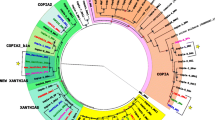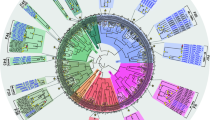Abstract
Genomic searches for P-like transposable elements were performed (1) in silico in the 12 available Drosophila genomes and (2) by PCR using degenerate primers in 21 Neotropical Drosophila species. In silico searches revealed P-like sequences only in Drosophila persimilis and Drosophila willistoni. Sixteen new P-like elements were obtained by PCR. These sequences were added to sequences of previously described P-like elements, and a phylogenetic analysis was performed. The subfamilies of P-elements described in the literature (Canonical, M, O, T, and K) were included in the reconstructed tree, and all were monophyletic. However, we suggest that some subfamilies can be enlarged, other subdivided, and some new subfamilies may be proposed, totalizing eleven subfamilies, most of which contain new P-like sequences. Our analyses support the monophyly of P-like elements in Drosophilidae. We suggest that, once these elements need host-specific factors to be mobilizable, the horizontal transfer (HT) of P-like elements may be inhibited among more distant taxa. Nevertheless, HT among Drosophilidae species appears to be a common phenomenon.


Similar content being viewed by others
References
Abascal F, Zardoya R, Posada D (2005) ProtTest: selection of best-fit models of protein evolution. Bioinformatics 21:2104–2105
Akaike H (1974) A new look at the statistical model identification. IEEE Trans Autom Control 19:716–723
Altschul SF, Madden TL, Schaffer AA, Zhang J, Zhang Z, Miller W, Lipman DJ (1997) Gapped BLAST and PSI-BLAST: a new generation of protein database search programs. Nucleic Acids Res 25:3389–3402
Arensburger P, Hice RH, Zhou L, Smith RC, Tom AC, Wright JA, Knapp J, O’Brochta DA, Craig NL, Atkinson PW (2011) Phylogenetic and functional characterization of the hAT transposon superfamily. Genetics 188:45–57. doi:10.1534/genetics.111.126813
Bartolomé C, Bello X, Maside X (2009) Widespread evidence for horizontal transfer of transposable elements across Drosophila genomes. Genome Biol 10:R22. doi:10.1186/gb-2009-10-2-r22
Bingham PM, Kidwell MG, Rubin GM (1982) The molecular basis of P-M hybrid dysgenesis: the role of the P element, a P strain-specific transposon family. Cell 29:995–1004
Bregliano J, Kidwell MG (1983) Hybrid dysgenesis determinants. In: Shapiro J (ed) Mobile genetic elements. Academic Press, New York, pp 363–410
Brookfield JFK, Montgomery E, Langley CH (1984) Apparent absence of transposable elements related to the P elements of Drosophila melanogaster in other species of Drosophila. Nature 310:330–332
Capy P, Bazin C, Higuet D, Langin T (1998) Dynamics and evolution of transposable elements. Landes Bioscience, Austin
Carvalho MO, Silva JC, Loreto ELS (2004) Analyses of P-like transposable element sequences from the genome of Anopheles gambiae. Insect Mol Biol 13:55–63
Castro JP, Carareto CMA (2004) Characterization of two full-sized P elements from Drosophila sturtevanti and Drosophila prosaltans. Genet Mol Biol 27:373–377. doi:10.1590/S1415-47572004000300011
Clark JB, Kidwell MG (1997) A phylogenetic perspective on P transposable element evolution in Drosophila. Proc Natl Acad Sci USA 94:11428–11433
Clark JB, Maddison WP, Kidwell MG (1994) Phylogenetic analysis supports horizontal transfer of P transposable elements. Mol Biol Evol 11:40–50
Clark JB, Altheide TK, Schlosser MJ, Kidwell MG (1995) Molecular evolution of P transposable elements in the genus Drosophila. I. The saltans and willistoni species groups. Mol Biol Evol 12:902–913
Daniels SB, Peterson KR, Strausbaugh LD, Kidwell MG, Chovnick A (1990) Evidence for horizontal transmission of the P transposable element between Drosophila species. Genetics 124:339–355
Engels WR (1989) P-elements in Drosophila melanogaster. In: Berg DE, Howe MM (eds) Mobile DNA. American Society for Microbiology, Washington, pp 437–484
Garcia-Fernàndez J, Bayascas-Ramírez JR, Marfany G, Muñoz-Mármol AM, Casali A, Baguñà J, Saló E (1995) High copy number of highly similar mariner-like transposons in planarian (Platyhelminthe): evidence for a trans-phyla horizontal transfer. Mol Biol Evol 12:421–431
Graur D, Li W-H (2000) Fundamentals of molecular evolution, 2nd edn. Sinauer Associates, Sunderland
Grumbling G, Strelets V (2006) FlyBase: anatomical data, images and queries. Nucleic Acids Res 34:D484–D488. doi:10.1093/nar/gkj068
Guindon S, Gascuel O (2003) A simple, fast, and accurate algorithm to estimate large phylogenies by maximum likelihood. Syst Biol 52(5):696–704. doi:10.1080/10635150390235520
Hagemann S, Pinsker W (2001) Drosophila P transposons in the human genome? Mol Biol Evol 18:1979–1982
Hagemann S, Miller WJ, Pinsker W (1992) Identification of a complete P element in the genome of Drosophila bifasciata. Nucleic Acids Res 20:409–413
Hagemann S, Miller WJ, Pinsker W (1994) Two distinct P element subfamilies in the genome of Drosophila bifasciata. Mol Gen Genet 244:168–175
Hagemann S, Haring E, Pinsker W (1996a) Repeated horizontal transfer of P transposons between Scaptomyza pallida and Drosophila bifasciata. Genetica 98:43–51
Hagemann S, Haring E, Pinsker W (1996b) A new P element subfamily from Drosophila tristis, D. ambigua, and D. obscura. Genome 39:978–985
Hammer SE, Strehl S, Hagemann S (2005) Homologs of Drosophila P transposons were mobile in zebrafish but have been domesticated in a common ancestor of chicken and human. Mol Biol Evol 22:833–844. doi:10.1093/molbev/msi068
Huelsenbeck JP, Ronquist F (2001) MrBayes: Bayesian inference of phylogenetic trees. Bioinformatics 17:754–755
Jones DT, Taylor WR, Thornton JM (1992) The rapid generation of mutation data matrices from protein sequences. Comput Appl Biosci 8:275–282
Kidwell MG, Kidwell JF, Sved JA (1977) Hybrid dysgenesis in Drosophila melanogaster: a syndrome of aberrant traits including mutation, sterility, and male recombination. Genetics 86:813–833
Kimbacher S, Gerstl I, Velimirov B, Hagemann S (2009) Drosophila P transposons of the urochordata Ciona intestinalis. Mol Genet Genomics 282:165–172. doi:10.1007/s00438-009-0453-7
Lansman RA, Stacey SN, Grigliatti TA, Brock HW (1985) Sequences homologous to the P mobile element of Drosophila melanogaster are widely distributed in the subgenus Sophophora. Nature 318:561–563
Lee SH, Clark JB, Kidwell MG (1999) A P element-homologous sequence in the house fly, Musca domestica. Insect Mol Biol 8:491–500
Lerat E, Burlet N, Biémont C, Vieira C (2011) Comparative analysis of transposable elements in the melanogaster subgroup sequenced genomes. Gene 473(2):100–109. doi:10.1016/j.gene.2010.11.009
Ludwig A, Valente VLS, Loreto ELS (2008) Multiple invasions of Errantivirus in the genus Drosophila. Insect Mol Biol 17(2):113–124. doi:10.1111/j.1365-2583.2007.00787.x
Miller LH, Sakai RK, Romans P, Gwadz RW, Kantoff P, Coon HG (1987) Stable integration and expression of a bacterial gene in the mosquito Anopheles gambiae. Science 237:779–781
Nei M, Gojobori T (1986) Simple methods for estimating the numbers of synonymous and nonsynonymous nucleotide substitutions. Mol Biol Evol 3(5):418–426
Nene V, Wortman JR, Lawson D, Haas B, Kodira C et al (2007) Genome sequence of Aedes aegypt, a major arbovirus vector. Science 316:1718–1723. doi:10.1126/science.1138878
Nerón B, Ménager H, Maufrais C, Joly N, Maupetit J, Letort S, Carrere S, Tuffery P, Letondal C (2009) Mobyle: a new full web bioinformatics framework. Bioinformatics 25(22):3005–3011. doi:10.1093/bioinformatics/btp493
Nouaud D, Quesneville H, Anxolabéhère D (2003) Recurrent exon shuffling between distant P-element families. Mol Biol Evol 20(2):190–199. doi:10.1093/molbev/msg036
Nylander JAA (2004) MrModeltest v2. Program distributed by the author. Evolutionary Biology Centre, Uppsala University, Uppsala
O’Brochta DA, Handler AM (1988) Mobility of P elements in drosophilids and nondrosophilids. Proc Natl Acad Sci USA 85(16):6052–6056
Oliveira LFV, Wallau GL, Loreto ELS (2009) Isolation of high quality DNA: a protocol combining rennet and glass milk. Electron J Biotechnol 12:1–6. doi:10.2225/vol12-issue2-fulltext-4
Perkins HD, Howells AJ (1992) Genomic sequences with homology to the P element of Drosophila melanogaster occur in the blowfly Lucilia cuprina. Proc Natl Acad Sci USA 89:10753–10757
Posada D, Crandall KA (1998) Modeltest: testing the model of DNA substitution. Bioinformatics 14(9):817–818
R Development Core Team (2011) R: a language and environment for statistical computing. R Foundation for Statistical Computing, Vienna (Austria)
Rio DC, Barnes G, Laski FA, Rine J, Rubin GM (1988) Evidence for Drosophila P element transposase activity in mammalian cells and yeast. J Mol Biol 200(2):411–415
Rouault J, Casse N, Chénais B, Hua-Van A, Capy P (2009) Automatic classification within families of transposable elements: application to the mariner family. Gene 448:227–232. doi:10.1016/j.gene.2009.08.009
Rubin GM, Kidwell MG, Bingham PM (1982) The molecular basis of P-M hybrid dysgenesis: the nature of induced mutations. Cell 29:987–994
Saitou N, Nei M (1987) The Neighbor-Joining method—a new method for reconstructing phylogenetic trees. Mol Biol Evol 4:406–425
Sarkar A, Sengupta R, Krzywinski J, Wang X, Roth C, Collins FH (2003) P elements are found in the genomes of nematoceran insects of the genus Anopheles. Insect Biochem Mol Biol 33:381–387. doi:10.1016/S0965-1748(03)00004-3
Setta N, Loreto EL, Carareto CMA (2007) Is the evolutionary history of the O-type P element in the saltans and willistoni groups of Drosophila similar to that of the canonical P element? J Mol Evol 65:715–724. doi:10.1007/s00239-007-9051-7
Sharp PM, Li WH (1989) On the rate of DNA sequences evolution in Drosophila. J Mol Evol 28:398–402. doi:10.1007/BF02603075
Silva JC, Kidwell MG (2000) Horizontal transfer and selection in the evolution of P elements. Mol Biol Evol 17:1542–1557
Silva JC, Kidwell MG (2004) Evolution of P elements in natural populations of Drosophila willistoni and D. sturtevanti. Genetics 168:1323–1335. doi:10.1534/genetics.103.025775
Simonelig M, Anxolabéhère D (1991) A P element of Scaptomyza pallida is active in Drosophila melanogaster. Proc Natl Acad Sci USA 88:6102–6106
Staden R (1996) The Staden sequence analyses package. Mol Biotechnol 5:233–241
Swofford DL (2003) PAUP: Phylogenetic Analysis Using Parsimony (and other methods), Version 4. Sinauer Associates, Massachusetts
Tamura K, Peterson D, Peterson N, Stecher G, Nei M, Kumar S (2011) MEGA5: molecular evolutionary genetics analysis using maximum likelihood, evolutionary distance, and maximum parsimony methods. Mol Biol Evol 28:2731–2739. doi:10.1093/molbev/msr121
Vidal NM, Ludwig A, Loreto EL (2009) Evolution of Tom, 297, 17.6 and rover retrotransposons in Drosophilidae species. Mol Genet Genomics 282:351–362
Acknowledgments
We are grateful to Dr. Luciano Basso da Silva and to Dr. Marco Silva Gottschalk for their assistance in Drosophila species identification; M.Sc. Bruna Corrêa for help with the R scripts and two anonymous reviewers for suggestions. This work was supported by CNPq, CAPES (PNPD), and Pronex-FAPERGS (10/0028-7).
Author information
Authors and Affiliations
Corresponding author
Additional information
Communicated by G. Reuter.
Electronic supplementary material
Below is the link to the electronic supplementary material.
Rights and permissions
About this article
Cite this article
Loreto, E.L.S., Zambra, F.M.B., Ortiz, M.F. et al. New Drosophila P-like elements and reclassification of Drosophila P-elements subfamilies. Mol Genet Genomics 287, 531–540 (2012). https://doi.org/10.1007/s00438-012-0691-y
Received:
Accepted:
Published:
Issue Date:
DOI: https://doi.org/10.1007/s00438-012-0691-y




